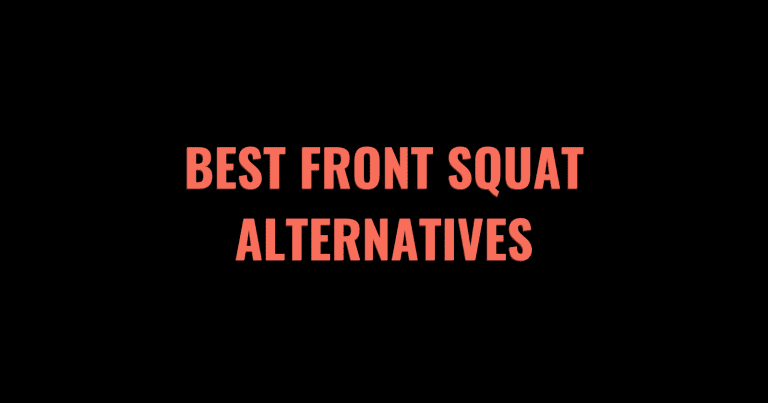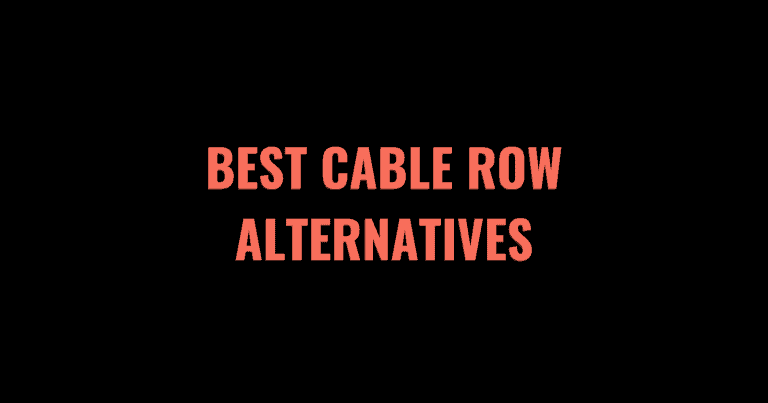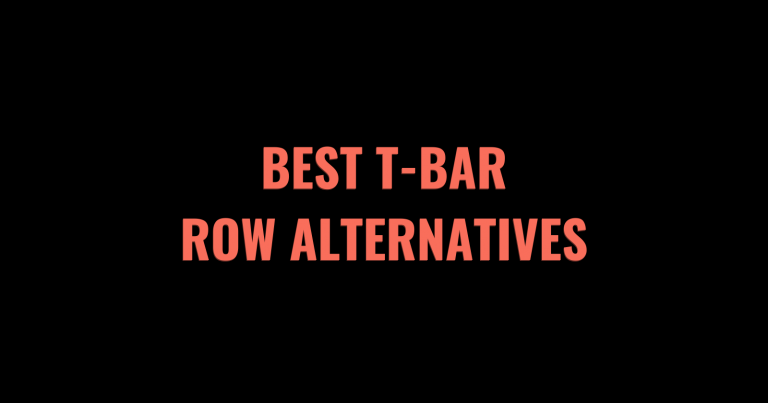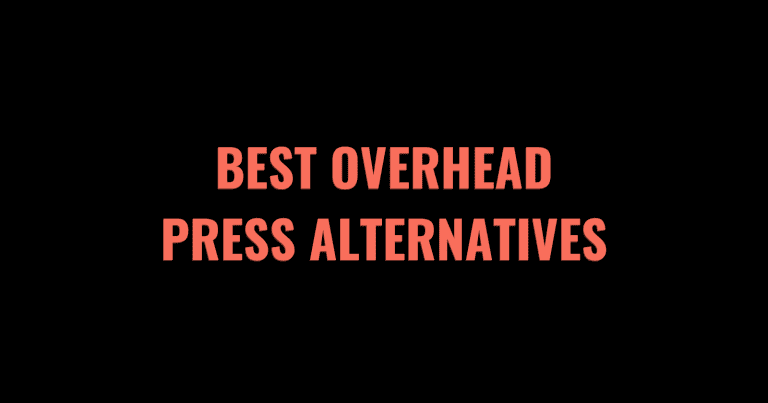One thing that unites most gym goers is a desire for thicker, stronger upper arms. We all know that bicep curls are a great way to grow bigger arms, but which curl variety should you choose?
One popular variation is the hammer curl which is performed with a neutral grip and emphasizes the brachialis and biceps brachii long head in your upper arm. Hammer curls are most often done using dumbbells, but you can also use cable machines, resistance bands, kettlebells, or weight plates.
Hammer curls are a great option, but there are many benefits to varying your exercise selection to target your muscles from multiple angles and with different types of equipment. Here is our list of the best hammer curl alternatives to keep your workouts fresh and build bigger, stronger upper arms.
Table of Contents
- 1 The 8 Best Hammer Curl Alternatives
- 2 Reasons to Choose a Hammer Curl Alternative
- 3 Muscles Worked by Hammer Curls
- 4 Hammer Curl Alternatives: FAQs
- 5 Other Alternative Exercises
- 5.1 The 10 Best Glute Bridge Alternatives
- 5.2 The 10 Best Romanian Deadlift Alternatives
- 5.3 The 10 Best Front Squat Alternatives
- 5.4 The 7 Best Deadlift Alternatives
- 5.5 The 10 Best Plank Alternatives
- 5.6 The 10 Best Bench Press Alternatives
- 5.7 The 10 Best Lat Pulldown Alternatives
- 5.8 The 8 Best Tricep Dip Alternatives
- 5.9 The 8 Best Incline Bench Press Alternative
- 5.10 The 9 Best Seated Cable Row Alternatives (2023)
- 5.11 The 9 Best T-Bar Row Alternatives
- 5.12 The 9 Best Lunge Alternatives
- 5.13 The 10 Best Hack Squat Alternatives
- 5.14 The 10 Best Pallof Press Alternatives
- 5.15 The 10 Best Overhead Press Alternatives
The 8 Best Hammer Curl Alternatives
- Neutral Grip Pull Ups
- Close Grip Chin Ups
- Dumbbell Hammer Preacher Curls
- Reverse Straight Barbell Curls
- Cable Hammer Curls
- Zottman Curls
- EZ Bar Reverse Barbell Curls
- Concentration Curls
1. Neutral Grip Pull Ups
When to Perform Neutral Grip Pull Ups
You may think of pull-ups as a back exercise, but using a neutral grip helps isolate your biceps and forearms (here’s a list of the top muscles worked by pull ups). Neutral grip pull-ups place less strain on the wrist and require more forearm grip strength than a traditional pull-up.
Not into pull ups? Check out our list of the best pull up alternatives.
How to Perform Neutral Grip Pull Ups
- Jump or step up to a parallel pull-up bar. Use a neutral grip so that your palms face inward.
- Hang from the bar with your arms extended.
- Brace your core, legs, and glutes for stability. Tuck your chin slightly to maintain a neutral spine.
- Flex your elbows and pull your bodyweight towards the bar.
- Pause when your chin hovers above the bar.
- Slowly extend your arms to return to a hanging position.
- Repeat for the desired number of sets and reps.
This video provides a helpful visual guide for performing neutral grip pull-ups.
Tips for Neutral Grip Pull Ups
If your gym doesn’t have neutral pull-up bars, you can also do this exercise using a standard horizontal high bar and a towel. Loop the towel over the top of the bar and grip each end with a neutral grip (palms facing inward). This configuration will mimic the neutral grip bar and target the same muscle groups as a hammer curl.
2. Close Grip Chin Ups
When to Perform Close Grip Chin Ups
Close grip chin-ups are a great bodyweight alternative to hammer curls. Performed with your hands closer than shoulder-width and a supinated or semi-supinated grip, this exercise shifts the focus from your back to your biceps, brachialis, and forearms. If you are looking for a hammer curl alternative that you can do without weights, this exercise is ideal.
How to Perform Close Grip Chin Ups
- Jump or step up to a pull-up bar. Grip it with a supinated grip (palms face you) and your hands 1-2 inches narrower than shoulder width.
- Hang from the bar with your arms extended until there is no swinging momentum.
- Brace your core, legs, and glutes for stability. Tuck your chin slightly to maintain a neutral spine.
- Flex your elbows and pull your bodyweight towards the bar.
- Pause when your chin hovers above the bar.
- Slowly extend your arms to return to a hanging position.
- Repeat for the desired number of sets and reps.
For a visual aid, check out this video from Coach PK of Strong Athlete.
Tips for Close Grip Chin Ups
Move through a full range of motion by ensuring your chin reaches over the bar for every rep. Lower yourself from the bar slowly and with control to engage more muscle fibers. Ensure you come to a dead hang between reps to minimize momentum and build strict strength.
3. Dumbbell Hammer Preacher Curls
When to Perform Dumbbell Hammer Preacher Curls
If your hammer curls have plateaued, unilateral variations like the dumbbell hammer preacher curl can help. Dumbbell hammer preacher curls can be done bilaterally (working both arms at the same time) or unilaterally. Unilateral movements address muscular imbalances, helping you to lift heavier weights overall. Using the preacher pad to support the back of your arms allows you to isolate the biceps, brachialis and forearms.
If you’re not familiar with hammer curls, check out our comparison of preacher curls vs bicep curls.
How to Perform Dumbbell Hammer Preacher Curls
- Position yourself on a preacher curl station with a dumbbell in one hand using a neutral grip.
- Support your tricep and elbow against the preacher pad and hold the dumbbell with your arm bent at 90 degrees.
- Slowly extend your elbow without moving your upper arm. Stop when your arm is straight but not hyperextended.
- Squeeze your biceps and forearms to curl the dumbbell up towards your shoulder.
- Repeat on the opposite arm.
- Repeat for the desired number of sets and reps per side.
Check out this video from Punch Supplements for a visual guide to performing the dumbbell hammer preacher curl.
Tips for Dumbbell Hammer Preacher Curls
Keep your working arm in one straight line throughout the exercise. Don’t let the forearm cave in or splay out. Move through a full range of motion, but don’t hyperextend your elbow at the bottom of the lift to avoid injury. You can also do this exercise with a straight or EZ barbell and a preacher pad if you prefer to train your arms bilaterally.
4. Reverse Straight Barbell Curls
When to Perform Reverse Straight Barbell Curls
If you prefer barbells or are limited to training with barbells, reverse straight barbell curls are the alternative for you. Reverse barbell curls engage more of your forearm flexors and brachialis than a standard barbell curl. Reverse curls improve your grip strength and help you to build thicker, stronger upper arms.
How to Perform Reverse Straight Barbell Curls
- Hold a barbell with a pronated (overhand) grip. Your hands should be a little wider than shoulder-width.
- Stand tall with a neutral spine. Engage your abdominals to protect your posture and provide stability.
- Keep your upper arms firmly tucked into your torso, and don’t let them move throughout your set.
- Keep your palms facing down and your wrists as straight as possible. Bend your elbows to curl the weight towards you.
- Pause when your forearms and biceps touch each other to ensure a full range of motion.
- Slowly extend your elbows and lower the barbell back to its starting position.
- Repeat for the desired number of sets and reps.
Check out this video from Scott Herman Fitness for a visual guide to performing the straight barbell reverse curl.
Tips for Reverse Straight Barbell Curls
Protect your wrists from strain or injury by actively gripping the barbell. Keep your forearms and wrists in one straight line, and don’t let your wrists bend. If this causes wrist or shoulder pain, you may prefer to use an EZ bar or dumbbells for reverse curls.
5. Cable Hammer Curls
When to Perform Cable Hammer Curls
Cable machines are great for beginners, lifters managing an injury, and even advanced lifters. Cables provide constant tension throughout the exercise, increasing the total amount of metabolic stress on the muscles. Using a rope handle attachment is the perfect substitute for dumbbell hammer curls as it uses a neutral grip and engages your muscles in the same way. Cable hammer curls require less core strength and stabilization, so you can focus all your attention on isolating your arms.
How to Perform Cable Hammer Curls
- Stand in front of a cable machine and attach a rope handle to the lowest pulley.
- Grip the ends of the rope with a neutral grip. Plant your feet at a hip-width distance and stand up tall.
- Engage your abdominals and your legs to keep your body stationary while you curl the cables.
- Lock your elbows into your sides, and don’t let them move throughout the set.
- Squeeze your biceps and forearms to curl the handles towards your upper chest.
- Stop when your biceps and forearms touch each other.
- Slowly release the weight by extending your elbows.
- Lower the rope handles until your arms are straight but not hyperextended.
- Repeat for the desired number of sets and reps.
For a visual guide to performing the cable hammer curl, here’s a useful video from Scott Herman Fitness.
Tips for Cable Hammer Curls
If you can’t access a cable machine, you can also use a long loop resistance band. Stand in the middle of the band with both feet and hold one end of the band in each hand. Use a neutral grip, with your palms facing each other. Keep your wrists engaged and curl the ends of the bands towards you.
6. Zottman Curls
When to Perform Zottman Curls
Zottman curls are the ideal alternative to hammer curls. They use the same muscle groups and follow a similar movement path. Zottman curls are a multi-movement exercise with two distinct phases. During the concentric (lifting) phase, you use a supinated grip. At the top of the lift, your forearms rotate so that your eccentric (lowering) phase is performed with a pronated grip. Zottman curls combine a standard dumbbell bicep curl with a reverse grip bicep curl, hitting your upper arms and forearms from multiple angles.
How to Perform Zottman Curls
- Stand tall with your feet hip-width distance apart. Hold a pair of dumbbells by your sides with a supinated grip (palms face forward) and your arms fully extended.
- Brace your core, legs and glutes to keep your torso stationary. Tuck your chin and look straight forward to keep a neutral spine.
- Squeeze your biceps and forearms to curl the dumbbells towards your shoulders.
- Pause when the dumbbells are near your shoulders, and your biceps and forearms are touching.
- Rotate your upper arms into a pronated grip (palms face the ground).
- Keep your wrists in line with your forearms by firmly gripping the dumbbells.
- Slowly extend your arms to lower the dumbbells towards your upper thighs.
- Pause when your arms are fully extended.
- Rotate your wrists back to a supinated position to reset for the next rep.
- Repeat for the desired number of sets and reps.
Here is a useful video from Testosterone Nation showing the correct form for Zottman curls.
Tips for Zottman Curls
Start with light weights for this exercise, especially if it is new for you. Zottman curls are an intermediate to advanced exercise, so it is important to perfect the technique before attempting heavier loads.
7. EZ Bar Reverse Barbell Curls
When to Perform EZ Bar Reverse Barbell Curls
Reverse barbell curls performed with an EZ bar are a great alternative to hammer curls. Compared to a straight barbell, EZ bars offer more flexibility to choose a grip that is most comfortable for you. If straight barbell reverse curls hurt your wrists, use an EZ bar with a semi-neutral grip.
To learn more about EZ bar curls, check out our comparison of the EZ bar curls vs straight bar curls.
How to Perform EZ Bar Reverse Barbell Curls
- Hold an EZ with a pronated (overhand) grip along the zig-zag section of the bar, so your thumbs are slightly higher than your pinkies.
- Stand tall with a neutral spine. Engage your abdominals to protect your posture and provide stability.
- Keep your upper arms firmly tucked into your torso, and don’t let them move throughout your set.
- Keep your palms facing down and your wrists as straight as possible. Curl the weight towards you.
- Pause when your forearms and biceps touch each other to ensure a full range of motion.
- Slowly extend your elbows and lower the barbell back to its starting position.
- Repeat for the desired number of sets and reps.
For a visual aid, check out this useful video from Chad Mollick demonstrating the proper technique for an EZ bar reverse curl.
Tips for Performing EZ Bar Reverse Barbell Curls
Keep your torso stable by engaging your abdominals throughout the exercise. When curling from a standing position, it is tempting to start swaying your back to generate momentum. Keep your whole body stationary with only your arms moving to isolate your biceps and forearms.
8. Concentration Curls
When to Perform Concentration Curls
Concentration curls are a fantastic unilateral bicep exercise that recruits your brachialis and brachioradialis, improves mind-to-muscle connection, and addresses muscular imbalances. The support from your inner thigh throughout the movement eliminates momentum and forces your muscles to work harder.
If you’re not familiar with concentration curls, check out our comparison of concentration curls vs bicep curls.
How to Perform Concentration Curls
- Grab the dumbbell with an underhand (supinated) grip with the arm you will use for your first set. With unilateral exercises, it can be helpful to start with your weaker arm first.
- Sit down on a bench with your feet planted and your knees apart to create space for the dumbbell to move.
- Tilt forward at the waist to lean over your legs and brace the tricep of the working arm against your inner thigh.
- Use your non-working arm to hold your opposite leg for additional support and stability.
- Keep the palm holding the dumbbell facing forward and breathe out as you squeeze the biceps to bring the weight towards you.
- Lift the dumbbell until your hand is close to the front of your shoulder and your bicep reaches maximum contraction.
- Hold for a moment. Breathe in as you slowly release the barbell back to a fully extended position. Ensure the arm remains braced, so you don’t hyperextend at the bottom of the lift.
- Repeat for the desired number of reps and repeat on the opposite arm.
For a visual aid, check out this video demonstrating the correct form for a dumbbell concentration curl.
Tips for Performing Concentration Curls
Don’t hyperextend your elbow at the bottom of the lift. Lower the weight slowly with control. Dropping the weight too quickly risks straining or injuring the elbow joint. Lift the dumbbell all the way to your shoulder to move through a full range of motion and engage as many muscle fibers as possible.
Reasons to Choose a Hammer Curl Alternative
Hammer curls are amazing for isolating the long head of your biceps. The long bicep head makes up the bulk of your bicep ‘peak’, making it a great choice for lifters wanting thicker upper arms. But if you want to target the entire biceps brachii muscle, you may prefer an alternative. Other reasons to choose a hammer curl alternative include:
- You don’t have access to sufficient dumbbells.
- You don’t like how hammer curls feel.
- Your grip strength gives out before your upper arms.
- You want to target your arms from a different angle.
- You want to vary your exercise selection to break through a training plateau.
- You want an alternative you can do from home or when traveling.
Muscles Worked by Hammer Curls
While traditional bicep curls target both the long and short heads of the biceps brachii, hammer curls isolate the long head of the biceps. Hammer curls also recruit the forearms and wrist muscles to stabilize the weight.
- Primary muscles used: Biceps Brachii (long head)
- Secondary muscles used: Biceps Brachii (short head), Brachioradialis and Brachialis (Forearm Flexors)
Hammer Curl Alternatives: FAQs
Are hammer curls better than bicep curls?
One exercise is not better than the other. They both effectively strengthen and build muscle in the upper body. Traditional bicep curls use a supinated position and target more of your biceps brachii. Hammer curls use a neutral grip and target the biceps, the brachialis, and brachioradialis.
Should I do curling exercises with dumbbells, barbells, or cables?
The best equipment for you depends on consistent accessibility and preference. Free weights like dumbbells and barbells force your muscles to work against gravity. The hardest part of the lift is usually at the top or bottom range of motion. Cables and resistance bands provide constant tension, and offer more stabilization support than free weights.
What advantages do hammer curls have over bicep curls?
Hammer curls and bicep curls strengthen your biceps and use the forearm flexors and brachialis to varying degrees. One advantage of the hammer curl is improved grip strength. Grip strength helps you go heavier on other lifts such as barbell rows and deadlifts.
Other Alternative Exercises
If you enjoyed this post, check out our other roundups of the best alternatives for other exercises.














